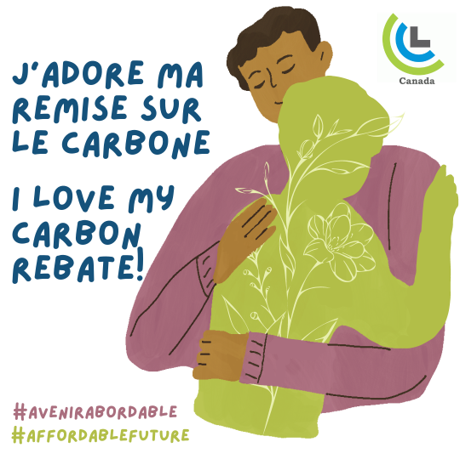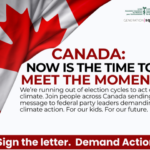Cathy Orlando is the National Director of Citizens’ Climate Lobby Canada (CCL) and Director of Programs at Citizens’ Climate International (CCI). I have taken the liberty to share with you an article she wrote that describes the carbon pricing and rebate program the Canadian federal government instituted and why its market mechanisms are designed to reduce carbon emissions while limiting the economic impact on average families.
When I was out in Western Canada last week, while eating lunch in Radium Hot Springs, our waitress described how carbon pricing was ripping her off and that she was paying more for everything because of it. I wish I had had Cathy’s article in my pocket at the time. The waitress didn’t believe climate change was a real problem. She didn’t understand the science and I wasn’t about to explain it to her. For her, climate change was a pocketbook issue. Food was costing more. Home heating was costing more. And the gas in her car was costing more. She was convinced she was getting the short end of the stick. That’s why I thought it would be helpful to take Cathy’s missive and share it with readers. It explains the rationale for pricing carbon pollution, why rebates are given to Canadian families, what climate change has been doing to food prices, and current greedflation being conducted by those in the food services and grocery business post-COVID and supply chain disruptions.
Please write to me with your comments and questions regarding carbon pricing, rebates, and how climate change is impacting you or not. But before you do, take 5 minutes to read Cathy’s article.
On July 15, Canadians in most provinces are getting something sure to put smiles on their faces: payment from the government for another quarterly Carbon Rebate.
The rebate is part of Canada’s program to put a fee on carbon pollution and give the revenue from the fee back to households. The additional income will come as relief to those who are feeling the economic pinch of higher food prices.
Several factors are pushing up food costs. One is a phenomenon referred to as greedflation. During the pandemic, supply chain issues and other factors increased costs for retailers, who then passed those costs on to their customers. Well, the pandemic and the problems it caused are essentially over, but instead of dropping prices, corporations decided to leave prices where they were so they could pocket the windfall profits.
Greedflation can be fixed with a government crackdown on companies that indulge in price gouging. However, there’s another problem driving up food costs that can’t be solved that easily — climate change.
As our climate heats up, food production is detrimentally impacted by more prolonged heat waves, longer droughts, extreme rainfall, and unnatural weather patterns such as the January cold snap that decimated fruit trees in the Okanagan. Did you know that heat disrupts the interaction between pollinators and plants that account for one-third of the world’s crops?
Bottom line: As climate change worsens, crop yields drop, pushing up prices. Frederic Neumann at financial services company HSBC, recently told the Financial Times, “It’s easy to shrug off individual events as being isolated, but we’ve just seen such a sequence of abnormal events and disruptions that, of course, add up to climate change impact.”
In the long term, reducing the inflationary pressure of climate change requires reducing the heat-trapping emissions that come primarily from the burning of fossil fuels.
The vast majority of economists agree that the most efficient and effective method to reduce emissions is to put a price on carbon and rebate the people. Canada leads the way with a carbon pricing policy that currently sets the price at $80 per tonne and will increase to $170 per tonne by 2030 with much bigger rebates in 2030.
Farmers and small businesses also are getting carbon rebates as are Canadians living outside cities who get a 20% top-up.
Does this increase energy costs? Yes, and that’s why the Canadian government is taking the revenue collected from putting a price on carbon and giving it to people in quarterly payments now being distributed. Canadians can use this money as they see fit. It can help cover higher energy and food costs.
Canada’s Carbon Rebate came about largely because citizens engaged our government and generated the political will to enact it. Between 2010 and 2018, volunteers with Citizens’ Climate Lobby Canada (CCL) collectively lobbied on Parliament Hill thirteen times and held 793 meetings with parliamentarians. CCL Canada generated nearly 3,000 letters to editors, opinion pieces, editorials and articles on the climate crisis and carbon pricing during that time.
It will take more than Canada’s efforts, of course, to stop climate change. Currently, over 60 countries have carbon pricing policies and there is a campaign to encourage other countries to price carbon pollution: The Global Carbon Pricing Challenge.
Canada is calling on all nations to use carbon pricing as a central part of their climate strategies. Citizens’ Climate Lobbyists in over 50 countries globally are building political will for pricing fossil fuel pollution in their countries too.
Slowing and reversing the impact of climate change on food production is a long-term endeavour, and it will be a while before people will see relief in the form of lower food prices. In the meantime, consumers can get some help with food bills by using money from the Canada Carbon Rebate. It’s a rare cure that can treat both the disease and its symptoms.
Canadians wishing to show support for their carbon rebate can send a letter to their parliamentarians by visiting the CCL website.









